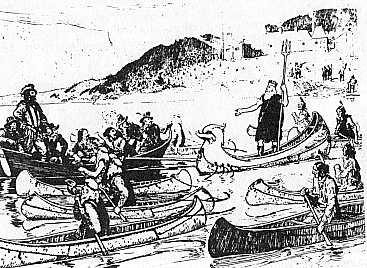Canadian Theatre Encyclopedia
Le Théâtre de Neptune en la Nouvelle-France

Widely reputed to be the first documented Western-style drama performed in this country (though there is speculation that some works were performed in the New World/Canada prior to this play). It was written by Parisian lawyer and poet Marc Lescarbot and played in Port Royal (in what is now Nova Scotia ) in November, 1606 to celebrate the return of Jean de Biencourt de Poutrincourt and Samuel de Champlain from their journey along the coastline to find a better site for the colony.
Le Théâtre de Neptune en la Nouvelle-France is written in the form of a masque, combining music, recital and choral song, as well as Glorias to the King of France, cannons and trumpets. It depicts Neptune and other classical mythical figures, and “Indians” welcoming travelers returning from a long sea voyage, and was performed by 70-80 Frenchmen, some of whom probably also performed the roles of the welcoming First Nations people.
It comprises a series of episodes in which Tritons give welcome speeches, and “savages” pledge allegiance to the King of France. There is a procession to the settlement, more speeches and a feast.
The piece was published by Lescarbot as part of a collection of poems in 1609, and was translated into English by by American historical preservationist Harriette Taber Richardson in the 1920s, and again by Canadian scholars Eugene and Renate Benson in the 1980s. A new edition of the original French script and the Bensons' translation was published in 2006 by Talonbooks under the title, Spectacle of Empire: Marc Lescarbot’s Theatre of Neptune in New France (400th Anniversary Commemorative Edition), edited by Jerry Wasserman
According to theatre critic, Alan Filewod, the masque was “a symbolic ritual that enacted the incorporation of this vast (and to the European eye) savage wilderness into the template of the French cultural imagination” – the celebration of the establishment of a French community in the “New World.” That it has long been considered Canada’s “first play” occludes the fact that First Nations peoples had been performing ceremonial rituals for hundreds of years before the arrival of Europeans, enacting their own values and beliefs through community performance. Filewod consider this performance “a defining moment that would be replayed for the next five centuries, a moment in which the theatre enacted an imagined authenticity even as it confirmed the extension of empire by tansmuting the work of colonialism into spectacle.”
Readings: Alan Filewod. Performing Canada: The Nation Enacted in the Imagined Theatre. Textual Studies in Canada. Kamloops B.C.: The University College of the Cariboo, 2002.
Donovan King. “A Dramaturgical Toolbox for Sinking Neptune.” http://optative.net/neptune/sinkingneptune.pdf
Profile by Gaetan Charlebois and Anne Nothof
Last updated 2010-12-31

